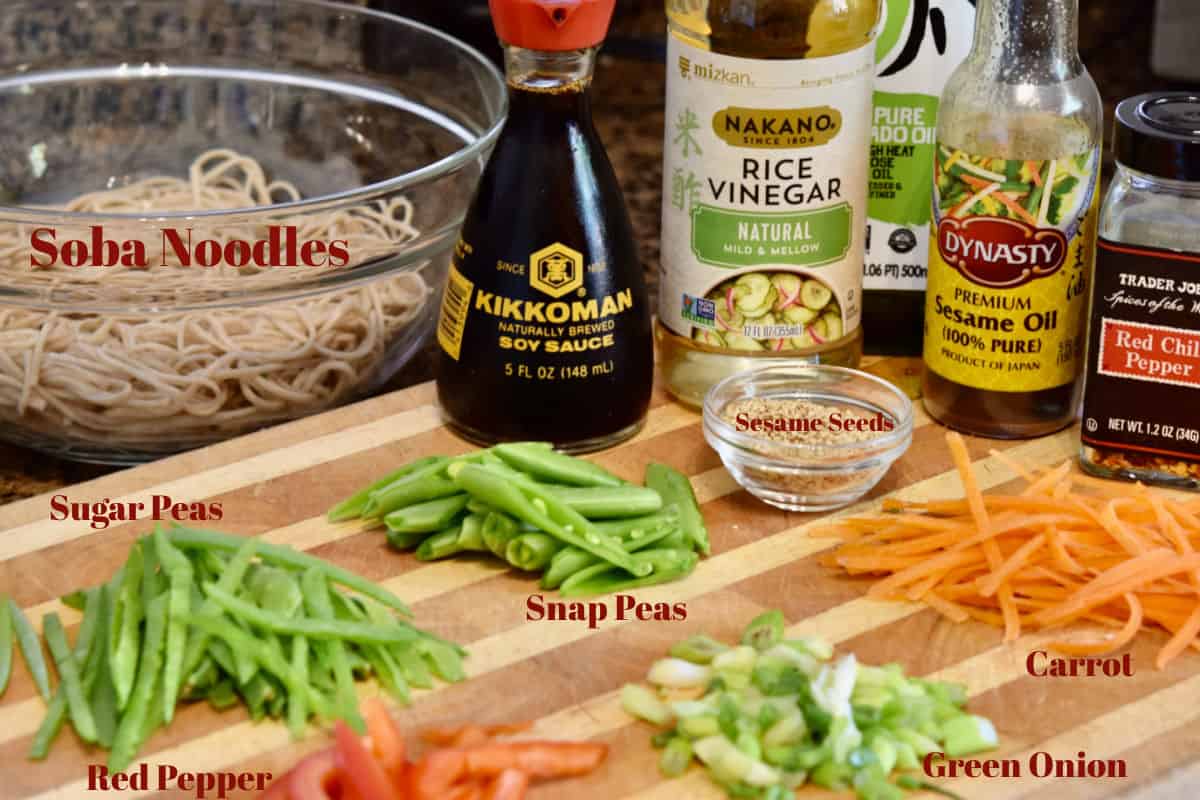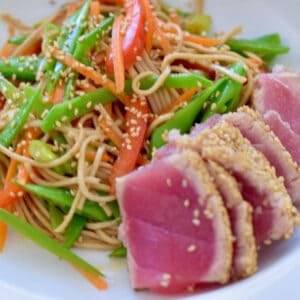Looking for a quick, refreshing meal? Asian Style Soba Salad with Seared Ahi Tuna is a fantastic choice. It's a delightful blend of chilled soba noodles, fresh veggies tossed together with a bright Asian dressing, and then topped with seared sesame-crusted Ahi tuna. Perfect for a satisfying, hassle-free dining experience.

Why Make this Dish?
- Refreshingly Delicious: This recipe combines chilled soba noodles, fresh veggies, and seared Ahi tuna, creating a refreshing and delightful flavor profile that's perfect for lunch or dinner.
- Quick and Easy: It's a breeze to prepare, making it ideal for those busy days when you want a tasty meal without spending hours in the kitchen. And 90% of it can be prepared in advance, even the day before.
- Healthy and Nutritious: Packed with protein, vitamins, and nutrients, it's a wholesome choice for a satisfying meal.
- Impress Your Guests: It's not just easy; it's also a showstopper. Serve this up at your next gathering, and you'll have everyone asking for the recipe
Jump to:
My Inspiration
Living in, rather than visiting Napa CA can be a shockingly expensive experience. While visiting tourists and wine lovers don't seem to mind spending a couple hundred for lunch or dinner when you live there it can be a bit too much. And it's hard to find a middle-of-the-road, non-chain restaurant to eat a meal. When we found NapaSport and discovered this salad for, at the time, <$20 it was a deal. Fresh seared sesame-coated ahi tuna with soba noodles and a plethora of fresh veggies, it hit every note I wanted to hit. And it was so easy that I was sure I could replicate it. So I did.
One of the most important parts of this recipe for Soba Noodle Salad with Seared Ahi is, to not overcook the fish! I've had a lot of experience with cooking rare tuna, such as in my recipes for Sesame Crusted Yellow Tail, Grilled Albacore Roast with Curry Mustard Sauce, and Simple Seared Ahi, and I know how overcooked fish can change the whole structure of the dish, so please, don't overcook the fish.
Ingredients and Substitutions

For the Dressing
- Neutral Oil - Use a neutral oil such as grapeseed, vegetable oil, or rice oil.
- Roasted Sesame Seed Oil - I keep my Sesame seed oil in the refrigerator as I don't use it often and it can turn rancid fairly quickly. Take the oil out of the refrigerator a few minutes prior to starting your dressing.
- Soy Sauce - I ALWAYS use low-sodium. You can add salt, but you can't take it away!
- Garlic Chili Sauce - Gives a little heat to the dish. Omit if you don't want any heat.
- Red Pepper Flakes - Again, for heat and flavor.
- Fish Sauce - Fish Sauce gives a deep flavor to the dressing. If you don't want to use it you can substitute Oyster sauce.
- Fresh Ginger - The fresh ginger rounds out the flavor of the dressing. I prefer the flavor of fresh ginger but you could use dried. Using equivalents from Better Homes and Gardens, one teaspoon of ground ginger can be replaced with four tablespoons of fresh.
For the Soba Noodle Salad
- Soba (Buckwheat) Noodles - As an alternative, you could use Udon, whole-wheat angel hair pasta, or thin spaghetti. If you want to keep it gluten-free, use a gluten-free thin noodle
- Snap Peas
- Snow Peas
- Carrot
- Red Bell Pepper

And of course, fresh sushi grade ahi tuna and sesame seeds.
See recipe card for quantities.
FAQ
I use Buckwheat noodles (Soba) because it's a natural grain and contains all eight essential amino acids, including lysine, which is lacking in wheat.
Soba contains a type of polysaccharide that is easily digested. Soba noodles also contain antioxidants, and essential nutrients including choline, thiamine, and riboflavin.
And if your soba is made with 100% buckwheat, which it should be, it's also gluten-free.
Sushi-grade fish (or sashimi grade) is an unregulated term used to identify fish deemed safe for raw consumption. Most fish vendors will use the term "sushi grade" to indicate which of their supply is the freshest, highest quality, and treated with extra care to limit the risk of foodborne illnesses. The best way to insure you have the best quality fish is to go to a quality fish counter or fish market.
How to Make Soba Noodle Salad with Seared Ahi Tuna

In a pan of simmering salted water, blanch the snow and snap peas until bright green. Immediately place in an ice bath to stop the cooking process.

Mise en Place. Have all of your vegetables sliced, julienned, blanched, and at the ready.
TOP TIP: Can be made up to a day in advance to this point. Put a dash of oil over the soba noodles and toss. Cover the noodles and veggies separately and keep refrigerated until ready to sear the tuna.

Mix the dressing ingredients together then toss with the soba noodles and vegetables.

Heat a small amount of neutral oil in a skillet over medium-high heat. Add the sesame-crusted ahi tuna and cook quickly, searing until the sesame seeds turn a light brown (do not burn) while the ahi remains rare. About 1 ½ minutes per side.

Slice the tuna and place with the noodles and vegetables.
Top tip
Be sure to not overcook your fish. You want to cook it just until the sesame seeds are golden in color and the ahi tuna is just warm inside.
Wine Recommendation
For a delightful pairing with Asian Cold Soba Salad and Seared Ahi Tuna, I'd recommend a crisp and refreshing white wine, such as a Sauvignon Blanc or a Pinot Grigio. Here's why:
- Complementary Flavors: The clean and bright flavors of these white wines beautifully complement the fresh and slightly spicy notes in the salad. They won't overpower the delicate taste of the seared Ahi tuna.
- Acidity Harmony: Both Sauvignon Blanc and Pinot Grigio have a good level of acidity, which helps balance the richness of the Ahi tuna and enhances the overall dining experience.
- Cooling Effect: The chilled soba salad can benefit from the cooling effect of a well-chilled white wine, making it a refreshing combo.
So, grab a bottle of one of these wines, chill it nicely, and you're in for a perfect pairing with your delicious meal.
How about Sake?
Sake can be an excellent choice with Asian-style dishes like Cold Soba Salad and Seared Ahi Tuna. The clean, slightly floral notes of sake can complement the flavors in this dish, and its lower acidity won't overpower the delicate tuna. It can create a harmonious pairing that enhances the overall dining experience. So, if you're a sake fan, go for it, and enjoy the unique combination of flavors

Related
Looking for other recipes using soba? Try these:

Asian Style Soba Noodle Salad with Seared Ahi Tuna Recipe
Ingredients
For the Dressing
- 1 tablespoon Neutral Oil grapeseed, vegetables, rice
- 2 tablespoons Toasted Sesame Seed Oil
- 1 teaspoon Chili garlic sauce
- ½ teaspoon Red chili flakes or to taste
- 3 tablespoons Low-Sodium soy sauce
- ½ teaspoon Fish sauce
- ½ teaspoon Fresh ginger grated
For the Asian Soba Salad
- 4 ounces Soba (Buckwheat) noodles Cooked according to package directions, drained and rinsed with cold water.
- ¾ cup Sugar peas juliened
- ½ cup Snap peas cut into halves on the bias
- ½ cup Carrot julienned
- ½ large Bell Pepper sliced thinly lengthwise
- 4 Green onions Slice thinly on the bias
- 1 tablespoon Toasted sesame seeds Can be all white, or a combo of white and black
For the Tuna
- 6 ounces Fresh Ahi tuna steak
- Sesame seeds to coat
- 1 teaspoon Neutral oil
Instructions
For the Dressing
- Mix the ingredients together in a small bowl or cup. Taste for salt, pepper, and heat. Set aside.
For the Salad
- Blanch the snow peas and snap peas in simmering salted water until bright green in color, immediately place in an ice bath (ice mixed with water). Once they are cool, drain, pat dry and set aside. In a large bowl mix the cold soba noodles with the cold vegetables, toss with the dressing. Taste and adjust seasonings. Divide the salad between two large bowls.
For the Sesame Seared Ahi
- Season the steak with salt and freshly ground pepper. Place some sesame seeds on a plate and press the fish into the seeds, coating both sides.Heat a skillet over medium-high heat, add a small amount of oil then add the Ahi steak. Cook, about 1 ½ minutes, or until the sesame seeds are lightly toasted, then turn and repeat on the other side.Cut the cooked steak into slices and serve next to, or on top of the salad.
Nutrition
Food safety
- Do not use the same utensils on cooked food, that previously touched raw meat
- Wash hands after touching raw meat
- Don't leave food sitting out at room temperature for extended periods
- Never leave cooking food unattended
- Use oils with high smoking point to avoid harmful compounds
- Always have good ventilation when using a gas stove





Brian
Wow!
Show stopper is right….and taste is great. I think this can also be paired with a red Rhône blend, I think the meatiness of the fish will hold up to the fuller body of a Rhône.